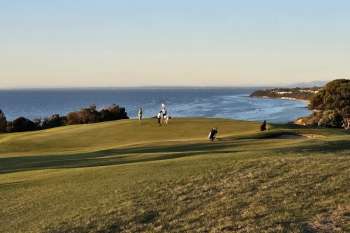Earlier this year I was given the opportunity to interview Greg Norman one-on-one about his burgeoning design business, and philosophies on the game of golf. Our forthright and, at times, lively discussion covered issues such as the closure of his Australian design office, the health of the local industry and, most contentiously, the work done on previous projects by former employees like Bob Harrison. A series of follow-up questions were answered by email – here below are highlights from the interview.
INTERVIEW – Greg Norman Q&A
DO - I want to ask firstly about the closure of your Sydney office, was that a tough decision?
GN - The decision to close the Sydney office was just as difficult as when I had to layoff long-time employees from my Florida office because of the downturn in the economy.
DO - In your book ‘The Way of the Shark’ (published 2006) you talk about the advantages of having an Australian office, of having short supply lines and being able to provide responsive, hands-on service to your clients in this region. It obviously worked well, and I wonder what confidence new clients can have that future courses will be designed and built to the same standards as previous Australian projects?
GN - When I wrote the book, the potential growth in the development of the game of golf in China wasn’t even on the radar screen. Any and all of my new clients should be extremely confident in the fact that they have a global operation supporting each and every endeavor in which we are involved. It doesn’t matter whether it is Australia, Asia, Middle East or any continent where I am designing and building projects.
DO - Who will now be responsible for the design and supervision work done on previous projects by Bob Harrison and (more recently) Harley Kruse? Will Jason McCoy service all Australian clients, or do you now have time to be more hands-on during this process?
GN - You are correct, Jason McCoy and I will service all Australian clients. As in the past, I will continue to be very hands on.
DO - When working here in Australia, will you send construction supervisors and shapers from Florida or use local guys?
GN - No we use local guys, we get asked to do design builds which are a huge advantage to a developer because you get somebody from head office on site monitoring the whole time. Cost savings are tremendous, implementation is tremendous so yeah, we always have somebody. Somebody from my head office will be here, sitting on a dozer working with David and Tim on the project (at Pelican Waters) so there is direct communication all the time. We do that all over the world, we just never did it in Australia and there were reasons why it couldn’t happen before in Australia. Now, because of the implementation of that, people are going WOW, now we’re getting the complete corporation behind it and support.
DO - How much credit do Harrison and Kruse deserve for the success of your Australian projects? Note: There were nine GNGCD courses on our most recent Top 100 ranking list.
GN - Bob Harrison and Harley Kruse deserve some credit to the success of the Australian projects, but like any employee, they had to go through a process of understanding my mindset on how I saw the golf course being designed and built. Like any of my projects, I try to teach and make sure each of my designers have a complete understanding of my concept. When your name is on the door, each project has to reflect my vision and mindset, and not that of any other individual within my organization.
DO - But do they deserve public credit?
GN - I give credit to all my guys all the time… they get credit where they deserve to get credit. I think at the end of the day when you work for a company, it’s Greg Norman Golf Course Design; it’s not a Bob Harrison Design OK simple as that. I’m sure that if you owned the company you’d probably feel the same way. If somebody’s saying ‘well I designed this but actually I’m working for this guy over here and I really didn’t design it because I’m actually working with him to do it.’
…So you give credit where credit is due and quite honestly the implementation of a design aspect, what I see and what I expect on the ground, because my name is on the door, I expect it to be implemented. I don’t expect to come back sometime and say oh that’s not what I wanted so you gotta redo it, because if you redo it somebody’s got to pay for it and I don’t believe in that. I pride myself on implementing things where the costing is kept to a minimum and obviously the execution long term you include in there. Long term is what I see, I see things 25 years down the line, 20 years down the line and I want to make sure those things implemented today are not handed off to somebody else in a very very expensive fashion.
DO - What specifically about Alister MacKenzie’s design ideals do you most associate with?
GN - I like the least disturbance approach. MacKenzie was a master at integrating a golf course into the most natural of terrain.
DO - Do you have favourite MacKenzie holes – perhaps outside Royal Melbourne and Australia?
GN - I enjoy playing any MacKenzie hole.
DO - Which of the other signature design firms in golf do you most respect and why?
GN - I have always had the utmost respect for Weiskopf, Crenshaw, Pete Dye and some of Jack Nicklaus’ courses.
DO - Your model of design and Nicklaus’s is very different to someone like European Golf Design or IMG Golf Course Services, where a design associate does the work and they just attach any old celebrity to the course.
GN - I don’t agree with that model. I was a consultant on two projects, and I didn’t like being a consultant on those projects because at the end of the day all they are doing is using your name, and they’re not using your experience or your expertise. Anybody can do that. I could go ask Darius Oliver to come in and be a consultant to Greg Norman Golf Course Design and give you x dollars and say go deal, OK. That doesn’t wash with me, to me your credentials and your credibility is independently running and owning and operating a company because your name is on the door.
DO - As the years progress do you see your competition coming more from genuine golf architects or the next wave of celebrity designer – say a McIlroy, Ishikawa, Villegas etc?
GN - I think there will always be a place for both genuine golf architects, and as you say celebrity designers, which I would call a Consultant. Consultants are asked by a potential developer/client to enhance the value of their projects outcome, either by the use of their name or their ability to incorporate a design philosophy, hence being consulted.
DO - Do you need a thick skin to be a golf course designer?
GN - No, just love what you do.
DO - What hurts more, criticism of you as a player or when you read critical comments about one of your courses?
GN - Neither one hurts, everyone is entitled to their opinion and not everyone will be 100% supportive of everything you do.
DO - You’ve spoken about the opportunities in places like China and India, but what do you see as the main challenges to the growth of golf in such regions?
GN - In China, I think it is imperative that both the central government and the different associations in each and every Province of China understands and learns from some of the mistakes that have been made in the past, i.e., the building of golf courses with unlimited budgets that took place in the 80s. Both China and India have to be responsible for growing the game at a sustainable level. By studying the mistakes made in the US in the 80s and 90s, China and India’s future in the world of golf will be huge.
DO - When considering a new course project, what’s more important to you – the client or the site?
GN - The client.
DO - This might be a silly question, but do you get more excited by great land or a flat site that you have to aggressively massage?
GN - I get equally excited with a great piece of property whether it is a flat site or hillside site. Both always test your mind and your deliverables.
DO - What’s a more worthwhile campaign do you think, trying to influence our governing bodies to act on the golf ball, or trying to convince golf clubs to ignore powerful professionals and focus instead on holes that 95% of the population can enjoy and find challenging?
GN - To me the most worthwhile campaign any institution or governing body should focus on is the growth of the game of golf. Whether that is managing technology or creating better incentives to bring people to the game.
DO - In terms of technology, how much better were places like Royal Melbourne, St Andrews and Augusta National to play during the 1980s compared with today?
GN - There are only a few of us who have the knowledge and experience to be able to draw comparisons about playing some of these great golf courses in the 80s, as they are played today. I believe it is all relative to some degree, but what I don’t like is when some of these great golf courses get lengthened for one week a year.
DO - What are your views on the current health of the Australian golf industry and its prospects moving forward?
GN - From what I have seen for the past few years with this dark cloud of the economy hanging over golf’s head, Australian golf and its industry has held its own. I currently have 13 golf courses under contract and 6 golf courses under construction in Australia. This is a testament to the strength of the Australian people, the love they have for the game and the Australian economy.
DO - In terms of GNGCD, is your long-term ambition to have as many courses as Nicklaus Design, or as many great courses as someone like MacKenzie?
GN - It’s not the quantity to me, that’s got nothing to do with it - it is the deliverable, which you have on the ground over a period of time is the thing that’s most important to me, and testimony to that is people’s memory of the golf course. I don’t build golf courses as a monument to myself, I build golf courses because I enjoy building golf courses for people, and so this is the big difference between me as an architect and what people think.
When discussion turned to golf course rankings…
GN - My course in San Antonio just got voted number 5 golf course just like that, in the first month and a half of being open. My guys email me that stuff all the time, I really don’t care, if they love the golf course that’s fine, I did my job great. You know accolades and all that comes with it, you know I go into every golf course design project hoping that that’s going to happen, but I don’t need it. I don’t want to be up there number 1 in golf course design or this and that…It’s the same philosophy I had in golf, I never wanted to be the number 1 player in the world, I only wanted to be the best player I could be. I just want to be the best golf course designer I can be.




